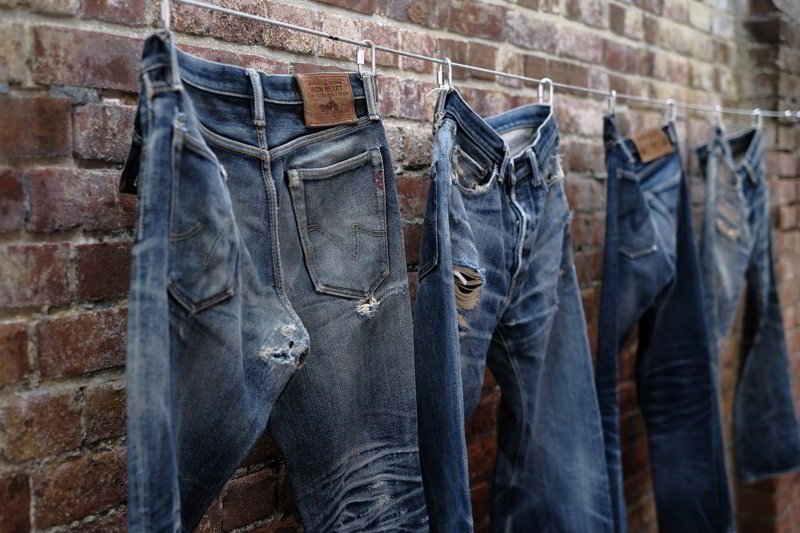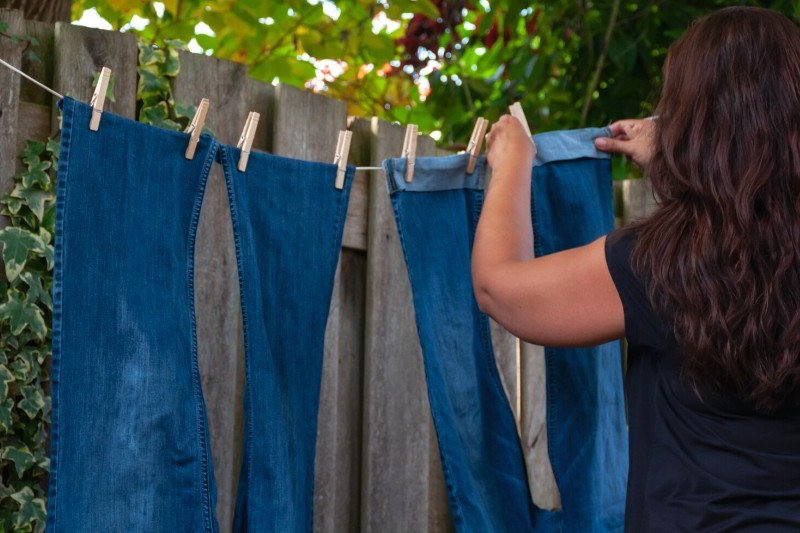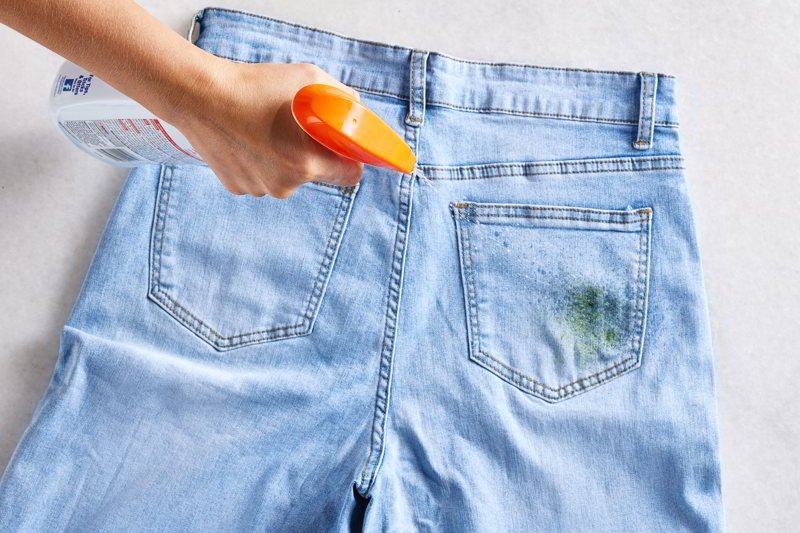Washing Denim Without Fading: Steps for Lasting Color
Denim jeans are a wardrobe essential, loved for their versatility and durability. However, one common frustration is how quickly the vibrant color of denim can fade with each wash. This guide provides a comprehensive look at preserving the rich color of your jeans. From understanding why denim fades to detailed washing and drying techniques, this article covers it all.
1. Understanding denim and fading
1.1 Why does denim fade?
Denim’s unique fading characteristic comes primarily from the indigo dye used to color it. Indigo dye, in its traditional form, doesn’t fully penetrate the cotton fibers. Instead, it sits on the surface of the yarn. This is why jeans develop those desirable fades, whiskering, and honeycombs over time.
When washed, the indigo dye molecules on the surface are gradually removed through abrasion and contact with water and detergent. This process of color loss is further accelerated by oxidation, a chemical reaction where the dye molecules interact with oxygen in the air and water, leading to a lighter color.
1.2 Types of denim and their fading tendencies
- Raw denim: Raw denim (unwashed, untreated denim) is the most susceptible to significant fading. Because it hasn’t been pre-washed, a large amount of indigo dye is still present on the surface, leading to more dramatic color loss with each wash.
- Selvedge denim: Selvedge denim (denim with a finished “self-edge” that prevents unraveling) can be raw or washed. Its fading tendency depends on whether it’s been pre-washed. Raw selvedge will fade more dramatically, while pre-washed selvedge will behave similarly to other washed denims.
- Washed denim: Washed denim (denim that has been pre-washed during production) has already lost some of its initial indigo dye. It will still fade, but the process will be slower and less dramatic than with raw denim.
- Stretch denim: Stretch denim (denim with added elastane or other stretchy fibers) can fade similarly to other washed denims. However, the synthetic fibers may be more prone to damage from high heat, which can indirectly affect the color.

1.3 Distinguishing different denim washes and finishes
- Light wash: Achieved through extensive washing and sometimes bleaching, light wash jeans have already lost a significant amount of indigo dye. They will continue to fade, but at a much slower rate.
- Medium wash: Representing a middle ground, medium wash jeans retain more indigo than light wash but have still undergone some pre-fading.
- Dark wash: Dark wash jeans have the highest concentration of indigo dye (aside from raw denim). They offer the greatest potential for dramatic fading over time, but also require the most care to prevent excessive color loss.
- Vintage wash: Vintage wash, which has a faded appearance resembling old, worn denim, also fades very slowly and does not change much over time.
- Distressed/whiskered: These finishes involve manually creating areas of wear and tear, often including pre-faded areas. These pre-faded areas won’t change much, but the surrounding, darker areas may continue to fade with washing.
2. Preparing your jeans for washing
2.1 Step 1: Turn jeans inside out
Before washing your jeans, turn them inside out. This is a simple but crucial step in protecting the exterior of your jeans. Turning them inside out minimizes the direct exposure of the dyed surface to the abrasive forces of the washing machine and the detergent. This will help prevent color loss.
2.2 Step 2: Check and secure fastenings
Before placing your jeans in the wash, ensure all zippers are zipped and all buttons are buttoned. This prevents the metal components from snagging on the denim fabric or other garments during the wash cycle, reducing the risk of tears or damage.
2.3 Step 3: Pre-treat stains
Before washing, inspect your jeans for any stains. Addressing stains beforehand increases the chances of complete removal and prevents them from setting further during the wash. For general stain pre-treatment, apply a small amount of mild detergent or a specialized stain remover directly to the affected area and gently work it in. For detailed guidance on handling specific types of stains (oil, ink, etc.), refer to this comprehensive stain removal guide.
2.4 Step 4: Separate by color
To maintain vibrant colors and prevent any unwanted color transfer, it’s essential to separate your jeans by color before washing. Wash dark-colored jeans (blacks, deep blues, etc.) together, and light-colored jeans (light blues, whites, pastels) in a separate load.
3. Washing your jeans: Machine wash
3.1 Choosing the right water temperature
Cold water is essential for preserving the color of your jeans. Hot water causes the cotton fibers in denim to expand, releasing more of the indigo dye and leading to faster fading. Cold water, on the other hand, keeps the fibers tighter, minimizing dye bleeding and helping to maintain the original color intensity.
3.2 Selecting the correct wash cycle
Always opt for the gentle or delicate cycle on your washing machine when washing jeans. These cycles use less agitation than regular or heavy-duty cycles. Excessive agitation causes more friction between the denim fibers and the washing machine drum, leading to increased wear and tear and accelerated fading. The gentle cycle provides a thorough clean while minimizing this abrasion.
3.3 Choosing the right detergent
The detergent can significantly impact the color retention of your jeans.
- Mild detergents: These detergents are formulated without harsh chemicals that can strip the dye from denim. They are a good option for regular washing.
- Color-safe detergents: Specifically designed to protect colors, these detergents often contain ingredients that help lock in dyes and prevent fading.
- Dark-color detergents: These detergents are formulated specifically for dark fabrics, including black and dark-wash jeans. They often contain color-enhancing agents that help maintain the depth and richness of dark colors.
Things to avoid:
- Bleach: Never use bleach on colored denim, as it will cause irreversible color loss and can damage the fibers.
- Fabric softener: Fabric softener can leave a residue on denim that can dull the color and affect the fabric’s texture. It’s best to avoid using it on jeans.
3.4 The vinegar and salt method
Adding distilled white vinegar and/or salt to the wash can help set the dye in denim and minimize fading.
- Vinegar: Vinegar acts as a natural fixative, helping to bind the dye molecules to the fabric. Add one cup of distilled white vinegar to the rinse cycle. Don’t worry about the vinegar smell; it will dissipate completely during the drying process.
- Salt: Salt can also help set the dye, particularly in new, unwashed jeans. Add one tablespoon of table salt to the wash cycle along with your detergent.
- Combined use: You can use both vinegar and salt together for maximum effect. Add the salt to the wash cycle and the vinegar to the rinse cycle.

4. Washing your jeans: Hand wash (optional)
4.1 When to consider hand washing
Hand washing is a gentler alternative to machine washing and may be preferred in certain situations:
- Delicate jeans: If you have jeans with embellishments, delicate stitching, or significant distressing, hand washing allows for more control and reduces the risk of damage.
- Raw denim: Some denim enthusiasts prefer to hand wash raw denim to minimize shrinkage and control the fading process.
- Personal preference: If you simply prefer a more hands-on approach and want to ensure the gentlest possible treatment for your jeans, hand washing is a viable option.
4.2 Step-by-step hand washing instructions
- Fill a basin: Fill a clean basin, tub, or sink with lukewarm water. Avoid hot water, as it can cause fading.
- Add detergent: Add a small amount of mild or color-safe detergent to the water. Swirl the water to distribute the detergent evenly.
- Submerge jeans: Turn your jeans inside out and fully submerge them in the water.
- Soak: Allow the jeans to soak for 30-60 minutes.
- Agitate gently: Gently agitate the water with your hands to loosen dirt and grime. Avoid scrubbing vigorously, as this can cause uneven fading.
- Rinse: Drain the soapy water and refill the basin with clean, cold water. Rinse the jeans thoroughly, repeating until all traces of detergent are gone.
- Remove excess water: Gently squeeze the excess water from the jeans. Do not wring or twist the fabric, as this can damage the fibers and cause wrinkles.
5. Drying your jeans properly
5.1 Air drying: The best method
Air drying is the best method for preserving the color, shape, and overall integrity of your jeans. Machine drying, even on low heat, exposes denim to high temperatures and tumbling that can cause shrinkage, fading, and damage to the fibers.
- Hanging: Hang your jeans by the waistband using clothespins or a hanger. This allows for good air circulation and helps prevent wrinkles.
- Location: Hang your jeans indoors or in a shaded area outdoors. Direct sunlight can cause significant fading, especially in dark-wash or raw denim.
- Shape: Smooth out any wrinkles or creases while the jeans are still damp. This will help them dry with a more natural shape.
- Inside out: To ensure minimal color fade, keep your jeans inside out as they air dry.

5.2 Using a dryer (only if necessary)
Using a dryer is generally not recommended for jeans. However, if you must use a dryer due to time constraints or other circumstances, follow these precautions:
- Low heat: Use the lowest heat setting possible (e.g., tumble dry low or delicate).
- Inside out: Turn your jeans inside out to protect the outer surface from direct heat and abrasion.
- Remove promptly: Remove the jeans from the dryer as soon as they are slightly damp. Over-drying can cause shrinkage and damage.
- Finish air drying: Hang the slightly damp jeans to finish air drying completely.
6. Special considerations for black and dark wash jeans
6.1 Increased fading risk
Black and dark wash jeans are more prone to visible fading than lighter washes. This is because they contain a higher concentration of dye, making any color loss more noticeable.
6.2 Reinforce importance of cold water, gentle cycle, special detergent
The washing recommendations discussed earlier are even more critical for black and dark wash jeans:
- Cold water: Always use cold water to minimize dye bleeding.
- Gentle cycle: The gentle cycle reduces abrasion and helps preserve the color.
- Special detergent: Use a mild detergent, a color-safe detergent, or, ideally, a detergent specifically formulated for dark colors.
6.3 Tips for minimizing fading
- Wash less frequently: The less you wash your black or dark wash jeans, the longer they will retain their color. Consider spot cleaning minor stains instead of washing the entire garment.
- Avoid harsh detergents and additives: Stick to mild or color-safe detergents and avoid bleach, fabric softener, and other harsh chemicals.
7. How often should you wash your jeans?
7.1 Balancing cleanliness and color preservation
Washing jeans too often can lead to premature fading and wear, while not washing them enough can result in dirt and odor buildup. Finding the right balance is key to keeping your jeans clean and preserving their color.
7.2 General recommendations
- Every 4-6 wears: For most jeans, washing every 4-6 wears is a good guideline. This allows for adequate cleaning without excessive washing.
- Raw denim: Raw denim enthusiasts often go much longer between washes (sometimes months) to achieve unique fading patterns. However, this requires careful spot cleaning and airing out.
- Individual needs: Adjust the washing frequency based on your lifestyle, activity level, and personal preference. If your jeans get heavily soiled or start to smell, wash them sooner.
7.3 Spot cleaning as an alternative
Spot cleaning is an excellent way to address minor stains or spills between washes. This reduces the need for full washing, helping to preserve color and extend the life of your jeans. Use a damp cloth and a small amount of mild detergent to gently clean the affected area.

8. Iron and steam
8.1 How to use iron with denim
Ironing denim is usually unnecessary if the jeans are air-dried properly. However, if you prefer a crisper look:
- Heat setting: Use a low to medium heat setting on your iron. High heat can scorch or damage denim fibers, and potentially alter the color.
- Inside out: Always iron jeans inside out. This protects the visible surface of the denim from direct heat and potential shine or discoloration.
- Pressing cloth: For added protection, consider using a pressing cloth (a thin, clean piece of cotton fabric) between the iron and the denim.
- Avoid creases: Don’t iron over existing creases. You might set them in place.
8.2 How to use steam with denim
Steaming is a gentler alternative to ironing for removing wrinkles from denim.
- Steamer type: A handheld garment steamer is ideal for jeans.
- Distance: Hold the steamer a few inches away from the fabric. Avoid direct contact, which can cause water spots or damage the fibers.
- Motion: Move the steamer continuously over the wrinkled areas. Don’t hold it in one spot for too long.
- Hang dry: After steaming, hang the jeans to allow any remaining moisture to evaporate and the fabric to relax.
9. Related questions
9.1 Can I use fabric softener on my jeans?
It’s generally not recommended to use fabric softener on jeans. Fabric softener can leave a residue that dulls the color and can affect the texture of the denim. It can also interfere with the breathability of the fabric.
9.2 How do I remove stubborn stains from my jeans?
Stubborn stains may require specific treatments depending on the type of stain. For detailed guidance on removing various stains (oil, ink, blood, etc.), refer to our comprehensive stain removal guide
9.3 Should I wash raw denim?
Raw denim care is a subject of much debate. Some enthusiasts never wash their raw denim, while others recommend infrequent washing. If you choose to wash raw denim, use cold water, a gentle cycle or hand wash, and a mild detergent. Be aware that raw denim will shrink and fade significantly with washing.
9.4 Can I fix jeans that have already faded?
While you can’t completely restore the original color of faded jeans, you can sometimes improve their appearance. Options include re-dyeing the jeans with a fabric dye or using a color-restoring product specifically designed for denim.
9.5 Does freezing jeans clean them?
Freezing jeans does not effectively clean them. While it may temporarily reduce odor-causing bacteria, it doesn’t remove dirt, stains, or other contaminants. Washing is the only way to truly clean jeans.
Read more:
Preserving the color and extending the life of your favorite jeans requires a combination of proper washing, drying, and general care practices. By turning your jeans inside out, using cold water and a gentle cycle, choosing the right detergent, and prioritizing air drying, you can significantly minimize fading and keep your denim looking its best.
Remember that washing less frequently and spot cleaning when possible are also key to maintaining the color and integrity of your jeans. Adopt these practices, and you’ll enjoy your favorite denim for years to come. Consider bookmarking this comprehensive guide for future reference, ensuring your denim always receives the care it deserves.























